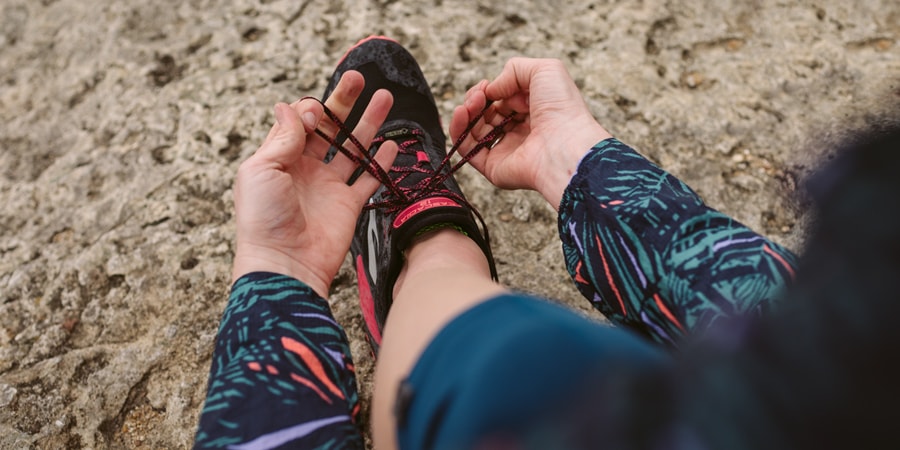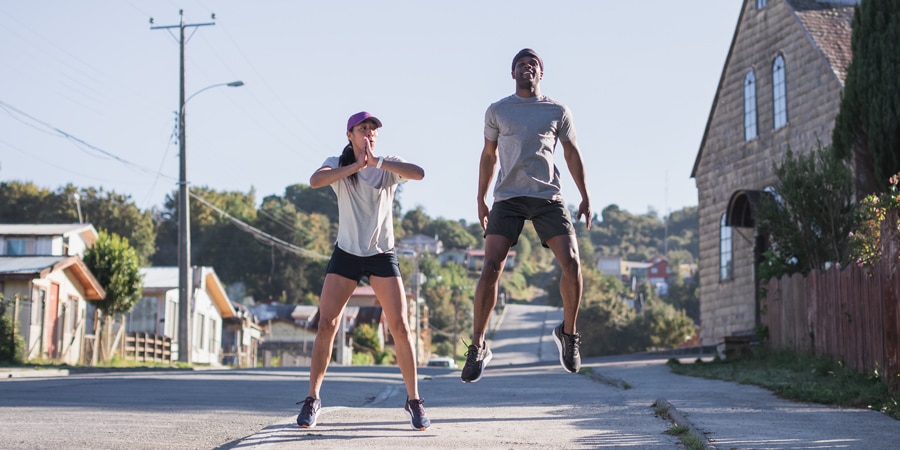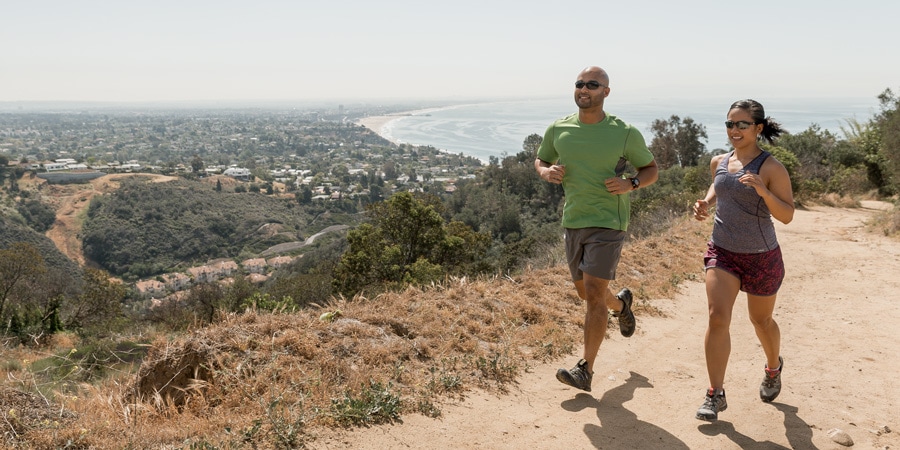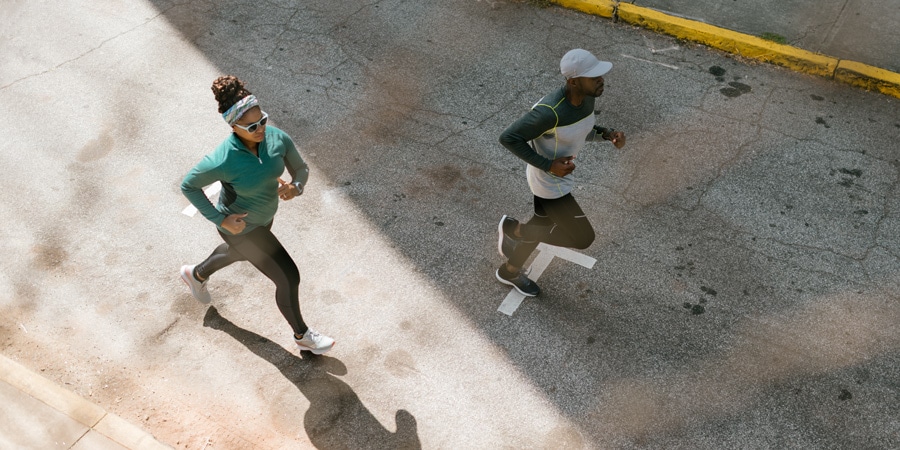One of the beauties of running is how simple it is to get started. With a good pair of running shoes, you can step out your door and get going—and you can do it at just about any age. Running is a great way to help improve your heart health, burn calories and boost your mood, among many other benefits.
Before you start any new exercise routine, check with your doctor. Running is a high-impact physical activity that can put added stress on your body. Make sure your joints and body can handle the impact, especially if you have been sedentary or have other health issues.
Once you're good to go, the steps to start a new running routine are simple:
- Start by walking: If you're new to exercise or have been sedentary for a while, start gently. Work your way up to walking briskly for 30 minutes a day, three to five times a week.
- Add running: Once you've been walking for a few weeks, incorporate periods of running into those 30 minutes. Warm up with 5 minutes of brisk walking and then gradually mix walking and running. Try running for 1 minute, walking for 2 minutes and repeating. As you become more comfortable running, lengthen the time you do it.
- Focus first on time and later build up your speed, stamina and mileage: Initially focus on increasing your time running rather than distance. The idea is to get out there and move, no matter how fast or slow you do it. Once you get your body moving consistently for a period of time, you can pick up the pace, build up your mileage or increase your endurance.
Running is an individualized sport that will look different for everyone. How often you run, how far or how fast will depend on your motivation and goals. Whether you hope to get fit or stay healthy, be social, have fun or tackle your first 5K or half marathon, knowing your motivation can help you tailor your (formal or informal) running plan.
Video: How to Get Started Running
Get the Gear

You don't need fancy fitness trackers or other electronics to get started running. But one thing you will need is a pair of running shoes that fit you well.
Find the right running shoe for you: While running shoes can be used for walking, walking shoes are not ideal for running—they do not offer the same cushioning and support. To understand more about your choices in running shoes and find a pair that will work for you, read our article, How to Choose Running Shoes.
Wear comfortable clothing: Whether you're running on a cold or hot day, choose comfortable running clothes that keep moisture (sweat) away from your skin and keep you dry. Read more in our article What to Wear Running.
Find a good-fitting sports bra: Because running is a high-impact sport, a good sports bra can help restrict breast movement that may lead to pain, chafing or other discomforts. Read tips on how to choose the type of support and style bra you need in the article How to Choose a Sports Bra.
Consider hydration: It's important to stay hydrated to feel your best on your run. You may be able to forgo drinking water on runs that are 45 minutes or less, but many runners carry and drink water regardless of how long they'll be running. Some like handheld water bottles, others prefer running hydration packs. Read more tips on what to drink and how much in our article Hydration for Runners.
Add accessories if you want: You don't need to geek out on fitness electronics or other accessories when you first start out. Those purchases can often wait until later. Once you catch the running bug, however, you may want to track your miles or your heart rate using a fitness watch or heart rate monitors. Read more on How to Choose Fitness Electronics.
The Basics of Running: FAQ
You don't have to overthink how you run, but a few tips on running form, pace and breathing can help you become a more efficient runner.

How should I warm up? Make time for 5-10 minutes of warmup to get your blood circulating, oxygen flowing and to wake up your body. Do dynamic stretches where you warm up your muscles through movement: Some examples include jumping jacks, high knees, butt kicks and leg swings.
How should I feel when I'm running? As a beginner, you might feel some discomfort when you start running, but if you're feeling pain, you should stop and check in with your doctor.
How fast should I run? Try holding a conversation with your running partner. If you can't talk comfortably, slow down. If you're running alone, try talking out loud to yourself and make sure you can do so comfortably.
How should I breathe while running? Your breathing is an important part of your run, helping to get oxygen to your muscles. Some people breathe through their noses, some through their mouths and others do a combination of both. Try different breathing techniques to see which works best for you.
Here are two common breathing patterns:
- Use a 2-2 pattern: Take a deep breath in for two steps (foot strikes) and breathe out through your mouth for two steps. Inhale through your nose, push out through your mouth.
- Use a 3-1 pattern: Take a breath in for three steps and exhale over one step.

What's proper running form? Good running form can help you become a more efficient runner and help prevent injuries. Here are some quick tips to get you started:
- Arms: Your arms are your power, while your legs are your strength. Let your arms swing naturally and at a relaxed 90-degree angle. Relax your shoulders, too. Avoid a skating motion; don't let your hands cross over the center line of your body. This helps to conserve energy.
- Feet: Land with your foot centered and directly under your body.
- Body: Keep your upper body upright yet relaxed. As you run, lean slightly forward so you have better momentum. Avoid hunching over or bending from your hips.
What's the best way to cool down? Take the time to gradually slow down your heart rate rather than stopping suddenly. You'll want to quiet your body and let it know it's time to rest. That will look different depending on your level of exertion. If you're running, slow down to a gentle trot or walk. If you're walking, transition into slow stretching such as 20-30 seconds of lunges.
Where's the best place to run? Find somewhere that offers you the opportunity to run consistently and where you enjoy doing it. In order to develop into a more versatile runner, eventually try varying your running surface. Run a mixture of streets, sidewalks, treadmills, tracks, grass, dirt road and so on.
How often should I run? Aim for frequency rather than speed or distance. Establish a weekly running schedule to get into the exercise habit.
How to Stay Motivated

Have a plan: Schedule your run. Put it on the calendar. Be consistent about it. If the only time you have to yourself is during your lunch break, schedule your run then. If the time before work or school is best, make that the time you do it. Set an alarm if needed. That said, listen to your body: If you don't feel like running one day, it's OK. It may be a sign that you and your body need a rest.
Get dressed: Sometimes the hardest part is getting motivated to get out the front door. Make a goal to get dressed to run so you have no excuse not to do it. Set aside or pack your running gear every day you intend to run so it's always ready for you.
Know your goal: Be intentional about why you're running—whether that goal is to stay healthy because you have high blood pressure or because you've signed up to run a 10K in three months. Remind yourself that today's effort will add up to something bigger in the long run.
Run with friends: It's harder to talk yourself out of a run when someone is waiting for you. Plus, you can motivate each other.
Join a running club: Find motivation from other runners. Join a local running club and join their online forums. Talk to other friends who run or connect with runners on online forums.
Sign up for a race: Once you're running regularly, you may start thinking about participating in a road race. They're often called "fun runs" since most runners do not enter them for serious competition. No matter your level of competitiveness, consider training for a race—even if your goal is simply to finish. Whatever the race distance—5K, 10K, half marathon or a full 26.2-mile marathon—set specific training goals over several months before your race.
Record your progress: Running apps or other online fitness trackers make it easy for you to track your progress and help you feel good about your accomplishments. Or go old school and record your runs, mileage and time in a journal or calendar.
How to Build Endurance

Once you've mastered basic running skills, start getting your body used to running for longer periods of time. The emphasis in this base-training phase is to build distance not speed. Running too fast, too soon can burn you out physically and mentally and make you more susceptible to injury.
Increase your miles slowly: Some runners recommend increasing your mileage, distance and intensity by no more than 10 percent per week to avoid overuse injuries. If you're new to exercising and running, you may want to start with a 5 percent increase per week. For example:
| Weekly Mileage | 5% Increase | 10% Increase |
|---|---|---|
| 10 | .5 mile | 1 mile |
| 20 | 1 mile | 2 miles |
Cross train: Do an activity other than running to give your legs and running muscles a break. Cycling, swimming, aerobic dance, cross-country skiing or using an elliptical trainer offer complementary aerobic exercises that can help you prevent burnout. It's less important to incorporate cross training during the initial few weeks of running when you're trying to establish a running base. Once you build up that running base and increase mileage, increase your cross training.
Strength train: Incorporate strength training to improve your efficiency and overall performance. There are many ways to strength train aside from lifting weights or using weight machines at the gym. There are simple exercises you can do at home to strengthen the muscles you use most when running. For a workout you can do at home, read more in Training Exercises for Running.
Rest and recover: As you build mileage, your body needs time to recover with rest days. Once you get past the walk/jog stage, then start running "long days/short days." For instance, if you do 4 miles one day, you might just do 2 miles the next day.
When you're ready to learn more, check out our other running articles.

